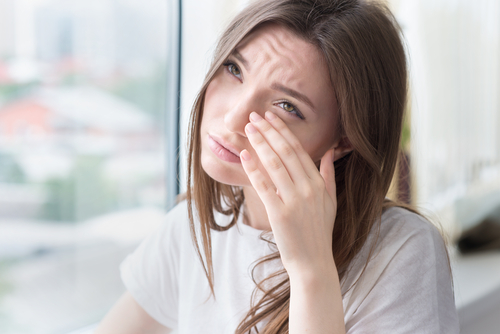Should I Treat My Dry Eye?
If you are experiencing red, irritated eyes, including a scratchy or gritty feeling, it could be a sign of dry eye syndrome. Dry eye syndrome may also cause your vision to be blurry, a burning sensation, or increased tearing.
Dry eye is very common and treatable. Keep reading to learn if you should treat your dry eye!
Dry Eye Syndrome Explained
A healthy eye maintains the right balance of moisture through tear production. Each time you blink, a film of tears spreads over your eye.
Tears wash away particles, keep the surface smooth, nourish and protect the eye. A healthy tear film has three layers: oil, water, and mucus. The oily layer smooths the surface of the tear and keeps tears from evaporating.
The water layer bathes and cleans the eye, washing away dirt and foreign particles. The mucus layer is sticky and moistens the eye’s surface by spreading the watery layer across the eye.
If the three layers don’t function properly or if your eyes do not produce enough tears, it can lead to dry eye syndrome.
Causes of Dry Eye Syndrome
The most significant risk factor of dry eye syndrome is aging. It’s common in women due to hormonal changes brought on by pregnancy, oral contraceptive use, and menopause.
Some other common causes are:
- Certain health conditions including rheumatoid arthritis, Sjögren’s syndrome, thyroid disease, and lupus
- Medications like antihistamines, decongestants, blood pressure medications, and antidepressants
- Eye conditions such as blepharitis, entropion, and ectropion.
- Activities like computer use for prolonged periods or reading can lead to reduced blinking, which increases your risk of dry eye.
- Wearing contact lenses over a long period
- Environmental conditions like exposure to smoke, wind, or an arid climate
Ways to Manage Dry Eye
There are some steps you can take to try to manage your dry eye symptoms at home. However, if your symptoms do not seem to improve, you may need to visit your eye doctor.
Take Fish Oil Supplements and Flaxseed
They contain omega-3 fatty acids and other key nutrients that support eye health.
Use Artificial Tears
Most people turn to over-the-counter lubricating eye drops to help keep their eyes moist and ease discomfort. Lubricating eye gels are thicker, stay in the eye longer, and are best for bedtime use.
Keep Your Eyelids Clean
Thoroughly scrub your eyelids, paying particular attention to the areas between your eyelash follicles. There are several over-the-counter cleansing eye gels and eye wipes that are designed for this purpose.
Treatments offered at Mid Ohio Eye
When over-the-counter and at-home methods do not adequately improve your dry eye symptoms, your eye doctor may recommend additional treatment. Some of the treatment options that the eye doctors at Mid Ohio Eye offer are:
Prescription Medications
Your eye doctor may prescribe medicated eye drops to treat your dry eye, including drugs to reduce eyelid inflammation and tear-stimulating medications.
Punctal Plugs
Punctal plugs can help relieve certain types of dry eyes. They are tiny silicone plugs inserted into the tear ducts to block drainage.
This increases the eye’s tear film, which improves surface moisture.
Punctal Cauterization
This is a procedure that permanently closes the tear ducts. Patients who respond well to punctal plugs are good candidates for cauterization.
The Boston Scleral Lens
This lens is a specially crafted contact lens that those with dry eyes can wear. It sits over the entire cornea, creating a fluid-filled reservoir that restores vision, provides continuous hydration, and improves long-term eye health and comfort.
Autologous Serum Drops
These are eye drops developed from a blood sample. The serum combines blood components and sterile saline, and its properties mimic your tears.
Are you interested in getting help determining which treatment method may be best for you? Schedule an appointment at Mid Ohio Eye in Columbus, OH, today!










